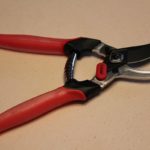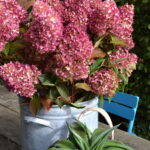
Panicle hydrangeas can turn rosy-red as the season cools down
In July, I wrote about web worms (Hyphantria cunea) on panicle hydrangeas. For the past several weeks, the second generation of web worms has been active in my neck of the woods. And boy, are they active! It seems every day they form new webs where none were the previous day. That will continue through October or until the first killing frost. Ugly doesn’t come close to what the plant looks like when these beasties are at work.
WEB WORMS LIFE CYCLE

Web worm nest on panicle hydrangea mars the look
Web worms are the larvae from moth eggs that were laid on the underside of foliage. The pupae survive the winter in a cocoon beneath ground litter and soil, and emerge the following year. The cycle begins anew as they mate and lay their eggs on the undersides of leaves. Once the larvae hatch (in about a week), they spin their web over the foliage so they can begin feeding. As you can conclude, fall clean up is key to prevention next year.
HOW TO TREAT WEB WORMS ON PANICLE HYDRANGEAS

Fall web worms on panicle hydrangea leaf
To treat for web worms, you can simply cut off the stem with the web on it. Put it in the trash, not the compost. However, if you’re like me, you want as many flowers as possible. In that case, fix the problem surgically. Break open the web and expose the worms to make a tasty meal for your birds. Or you can snip off and dispose of the damaged leaves, preserving your flower at the tip of the stem. Then look around: it’s likely you have web worms on other plants. It’s known to be active on over 100 plant species. I found them on my crabapples and redbuds. If the webs are too high to reach, use a long handled tool like a pole pruner, rake or broom to break open those webs.
INSECTICIDE TREATMENTS
If you must apply an insecticide, the one to use once you open the nest is Bacillus thuringiensis subspecies kurstaki (Btk), not Spinosad. Btk is the treatment that works on members of the moth family. Like most organic products, it is ineffective when it dries and only works on contact with the caterpillar: it must be ingested. You can’t spray preventively; you must target the caterpillar in the moment. Keep in mind that although Btk is an organic treatment, it is lethal to all caterpillars, including those that turn into butterflies. Just another reason to use a mechanical approach. But if the caterpillars are gone by the time you get to the nest, forget the Btk: the insecticide is useless. I prefer not to use an insecticide regardless. It’s low tech all the way for me.
The season is late so the impact of webworms on your plant is mostly cosmetic. But your plant has been stressed so treat it well until it goes dormant, making sure it gets watered if you have a dry fall. Do not fertilize but feel free to add compost – that’s always a good thing.
Regardless of where you find webworms, GET RID OF THEM!
UPCOMING PUBLIC HYDRANGEA TALKS
If you find yourself on Cape Cod this month (maybe you’re thinking about a trip there?), why not attend the Cape Cod Hydrangea Society meeting? I’ll be speaking to this illustrious group about The Magic Of Rebloomers.
DATE: Saturday, September 28, 10 a.m. Harwich Community Center, 100 Oak St, Harwich, MA 02645. Non-members can attend free of charge without pre-registration.
You can also check the calendar tab on my website for other speaking dates.
Hope to see you there!
###
6 Secrets for Stunning Hydrangea Flowers
Get my FREE mini-guide with 6 fool-proof tips showing how to grow hydrangeas that produce the most amazing flowers.
No spam - I promise!




